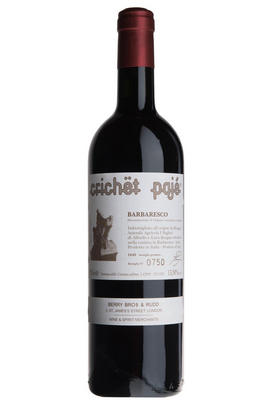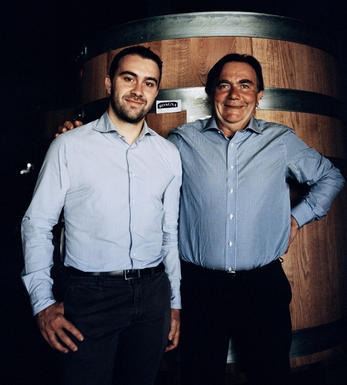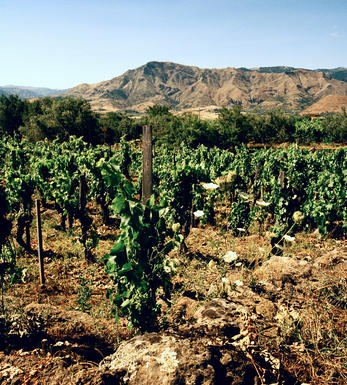
2010 Barbaresco, Crichët Pajé, Roagna, Piedmont, Italy

Critics reviews
Monica Larner - 28/06/2019
About this WINE

Roagna, Piedmont
Luca Roagna represents the latest generation to work in this historical wine estate, alongside his genial father Alfredo, whose 15 hectares of vine cover both Barbaresco and Barolo wine production. However the family's roots lie in Barbaresco, with Luca's grandfather buying the Paje vineyard in the 1950s.
The key to understanding Roagna's wine is their insistence upon biodiverse masale selected and old vineyards (up to 100 year-old in the case of Castiglione Falletto), whose plants are only green harvested up to 15 yo (older vines set their own yields naturally). Harvests tend to be more protracted than their neighbours, while cuvaisons in large conical French Garbellotto botte also outstrip the norm, lasting anything from one to two months, achieving the finest tannins and maximum extraction. The use of sulphur dioxide is minimal if applied at regular intervals.
The range is dominated by three Barbaresco crus: Paje, Crichet Paje and Paje Riserva; the difference being the exposition and vine age. Not afraid to innovate, since 1982 they have also offered an ingenious non-vintage, vino di tavola blend of (Barbaresco) Nebbiolo called 'Opera Prima' and since '88 a minerally white Chardonnay/Nebbiolo blend named 'Solea'.
From Barolo's Castiglione Falletto village comes their monopole and ancient vine 'La Rocca e Le Pira' cru, while more recently (from '93) comes Serralunga d'Alba's prime Vigna Rionda. Production is small; the 10,000 cases potential reduced to an average 6,000 case reality. In a word: finezza.

Barbaresco
The Piedmontese DOCG zone of Barbaresco is responsible for producing some of Italy’s finest wines. It occupies the same region and uses the same grape (Nebbiolo) as its bigger brother Barolo, but is a third of the size (only 640 hectares versus Barolo’s 1,700 hectares). It is also 50 years younger than Barolo, having produced wine labelled Barbaresco since 1890.
Barbaresco earned its DOCG after Barolo in 1980, largely thanks to the efforts of Angelo Gaja. The soils are lighter here than in Barolo – both in colour and weight – and more calcareous. The slopes are also less favourably situated and (relatively speaking) yield earlier-maturing yet extremely elegant wines that require less oak ageing (normally one year in oak plus six months in bottle). The appellation’s key districts are Barbaresco, Treiso, Neive and Alba.
Recommended producers: Cigliuti, Gaja, Marchesi di Gresy

Nebbiolo
Nebbiolo is the grape behind the Barolo and Barbaresco wines and is hardly ever seen outside the confines of Piedmont. It takes its name from "nebbia" which is Italian for fog, a frequent phenomenon in the region.
A notoriously pernickety grape, it requires sheltered south-facing sites and performs best on the well-drained calcareous marls to the north and south of Alba in the DOCG zones of Barbaresco and Barolo.
Langhe Nebbiolo is effectively the ‘second wine’ of Piedmont’s great Barolo & Barbarescos. This DOC is the only way Langhe producers can declassify their Barolo or Barbaresco fruit or wines to make an early-drinking style. Unlike Nebbiolo d’Alba, Langhe Nebbiolo can be cut with 15% other red indigenous varieties, such as Barbera or Dolcetto.
Nebbiolo flowers early and ripens late, so a long hang time, producing high levels of sugar, acidity and tannins; the challenge being to harvest the fruit with these three elements ripe and in balance. The best Barolos and Barbarescos are perfumed with aromas of tar, rose, mint, chocolate, liquorice and truffles. They age brilliantly and the very best need ten years to show at their best.


Buying options
Add to wishlist
Description
Alfredo and Luca chose not to release “CP” in the 2009 vintage, as they felt the quality was not there. Skip forward then from 2008 to 2010. From the sunniest, sought-after corner of the Pajè vineyard, old vines that produce achingly small yields, vinified in a single 20-hectolitre botte and aged for eight years prior to release; the 2010 expression brims with late-harvest, dried tamarind fruit. It is tightly woven, with a “block” of dark cherry spirit, rich with decadent gelato and currant fruit. It’s hedonistic but racy too. Drink now to 2045+.
Davy yw, Wine Buyer
wine at a glance
Delivery and quality guarantee